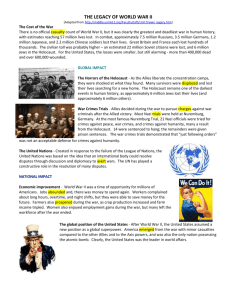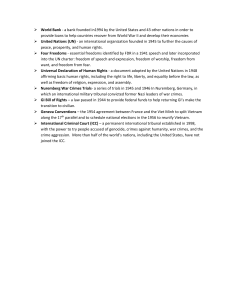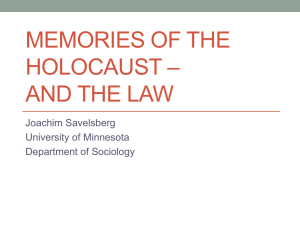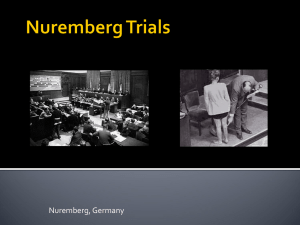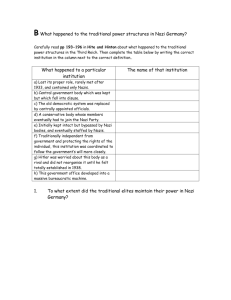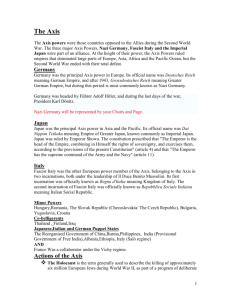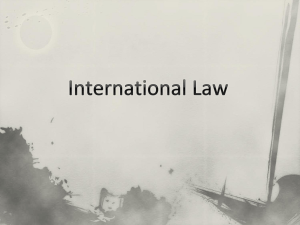The Nuremberg Trials - Freeman Public Schools
advertisement
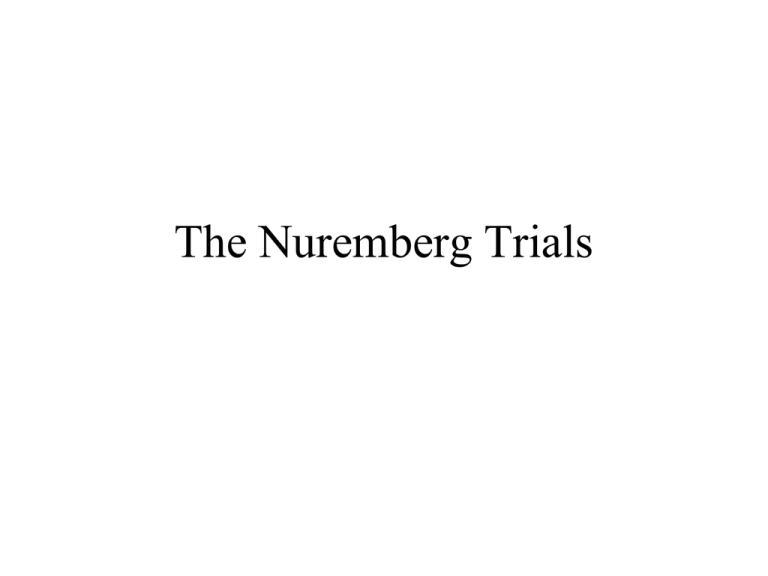
The Nuremberg Trials The Allies and the Trials • Winston Churchill did not want a trial – Thought all should be hung • Americans and Russians wanted a trial • How do you try people for the murder of millions of people that had been made “legal” under Hitler? The Lieber Code • Compiled by Frances Lieber and given to American soldiers during the Civil War – It detailed how civilians, prisoners of war, and spied were to be treated – Other nations, including Britain, France, and Germany prepared similar manuals – View the code – See important parts of the code The Hague • Held in 1907 in Hague, Netherlands – Focused on the rights of civilians and soldiers who have surrendered Previous Violations • World War I- Germany while unprovoked, invaded Belgium – Treaty of Versailles said Kaiser Wilhelm was to be tried for aggression, but those trials never took place • 1915- Turks massacred the Armenians in genocide- no trials took place • Video of Armenian Genocide Warnings • Oct. 25, 1941- joint warning from Churchill and Roosevelt that punishing war crimes would be a major goal of the war • Jan. 13, 1942- Inter-Allied Conference on the Punishment of War Crimes issued a joint resolution referring to the Hague Convention and the punishment of those responsible for war crimes Warnings • Nov. 1, 1943- Moscow Declaration issued by Roosevelt, Churchill, and Stalin. • “Let those who have hitherto not imbued their hands with innocent blood beware lest they join the rank of the guilty, for most assuredly, the Three Allied Powers will pursue them to the uttermost ends of the earth and deliver them to their accusers in order that just may be done.” Warnings • March 24, 1944- Roosevelt issues another appeal to the German people to disassociate themselves from the terrible crimes against humanity that are being carried out in their name. The Crimes • Crime of conspiracy – Leaders, organizers, instigators, and accomplices in the formulation or execution of a common plan, or a conspiracy to commit any of the following crimes are responsible for all acts performed by any persons in executing such a plan. The Crimes • Crimes against peace – Planning, preparing or initiating a war of aggression. • War Crimes – This meant breaking the rules of war. It included killing prisoners or war and destroying homes and property The Crimes • Crimes against humanity – The murder, extermination, enslavement, deportation, and other inhumane acts committed against any civilian population before or during the war. Who should be tried? • The first job facing the court at Nuremberg was to decide who should be tried. • 24 Nazi’s were indicted • 22 stood trial • The rest were turned over to local trials How the trials were set up • Allies formed the International Military Tribunal (IMT) to bring the Nazi leaders to trial – Tribunal is a court of justice • The defendants were made aware of all charges, each was entitled to a lawyer and had the right to plead his own case, offering witnesses and evidence on his behalf. Palace of Justice The Palace of Justice in Nuremberg, where the International Military Tribunal trial of war criminals was held. The flags of the four prosecuting countries (French, American, British, and Soviet) hang above the entrance. The Nuremberg Trials • Began Nov. 20, 1945 and lasted 10 months • Chief prosecutor was Robert H. Jackson, justice on United States Supreme Court – Opening Statement by Jackson Statement by Jackson • “We must never forget that the record on which we judge these defendants today is the record on which history will judge us tomorrow. To pass these defendants a poisoned chalice is to put it to our own lips as well.” • Click to hear link The Prosecution • Used the Nazi’s own records • Tried to show the Nazis planned a war and planned to conquer the world if they could – A crime against peace • A minor part of the prosecution was documents and witnesses of the Holocaust The Evidence • U.S. Army staffers organizing stacks of German documents collected by war crimes investigators as evidence for the International Military Tribunal. — National Archives and Records Administration, College Park, Md. The Defense • Too much evidence to claim the Holocaust didn’t happen – Had to make case on other issues • Said tribunal had no legal authority • Said they were just following orders The Defense • Vehemently denied responsibility for crimes against humanity The Defense • Used the argument Fuhrer-prinzip – Nazi “leadership principal” – All orders given in Germany were Hitler’s orders and the punishment for not obeying was death. The Nuremberg Trials • The details of what the Nazi’s had done became vivid to the rest of the world • After a trial that lasted nearly a year, verdicts were mixed Sentences • Martin Bormann – Hitler’s secretary, was tried in absentia, never captured, sentenced to die Sentences • Hermann Goering– – – – Highest ranking official, 2nd to Hitler Commanded the Luftwaffe Set up the Gestapo Sentenced to death, but took poison hours before he was to be hung Sentences • Jochaim von Ribbentrop – Hitler’s foreign minister – Deported Jews from occupied countries “to the East” Sentences • Julius Streicher – Published Der Stuermer, an antisemitic newspaper – Found guilty of “inciting the population to abuse, maltreat, and slay their fellow citizens.” Sentences • Rudolf Hess – The deputy leader of the Nazi Party – 3rd in command – Spent the rest of his life in Spandau prison in Berlin Later Trials • The first Nuremberg Trials were followed by a dozen others. • Those accused – Military leaders – High-ranking SS and police officers – Doctors who performed selections and medical experiments – Businessmen who used slave labor – USHMM article on later trials Later Trials • The Allies extradited many Nazis to nations once occupied by Germany • Norwegians convicted Prime Minister Vidkun Quisling • French convicted Henri-Philippe Petain Later Trials • Rudolf Hess – Tried by the Poles and the Czechs – Was the Commandant at Auschwitz – Sentenced to life in prison Results of the Nuremberg Trials • Told the world in great detail about the Holocaust • Established the principle that individuals can’t escape responsibility for their actions by saying they were following orders • Set the standards for judging the actions of nations in the future Geneva Conventions • Comprised of 4 treaties and 3 protocols that set the standards in international law for humanitarian treatment of the victims of war • Established how prisoners of war were to be treated and called for the protection of the wounded and civilians in and around a war zone • Have been ratified in whole or with reservations by 194 countries. Adolf Eichmann Trial • Some high ranking Nazis escaped from the Allies – One was Adolf Eichman • Did more than any other Nazi to persecute Jews • Was in charge of deporting Jews from all over Europe to death camps Tracking Down Eichmann • Simon Wiesenthal, a Holocaust survivor, was instrumental in tracking Eichmann to Argentina • Found in 1949, but by then, most countries had lost interest and would not extradite Nazis The Trial of Adolf Eichmann • April 11, 1961 Eichmann walks into a courtroom in Jerusalem, Isreal – Put in bulletproof glass booth, for his protection • Main focus was crimes against the Jewish people Eichmann’s Defense • His main defense was “just following orders” • He also lied about how much authority he had, what he knew, and what he did. Eichmann’s sentence • Was sentenced to death • He is the only person executed by the State of Israel Effect of Eichmann Trial • More Holocaust survivors came forward to tell their stories • More scholars studied the Holocaust “Nazi Hunters” • Individuals and organizations known as “Nazi Hunters” still actively seek to bring Nazis to trial. • The Butcher of Lyons was sentenced to life in prison in 1987. Is it ever too late to seek justice? View USHMM article
